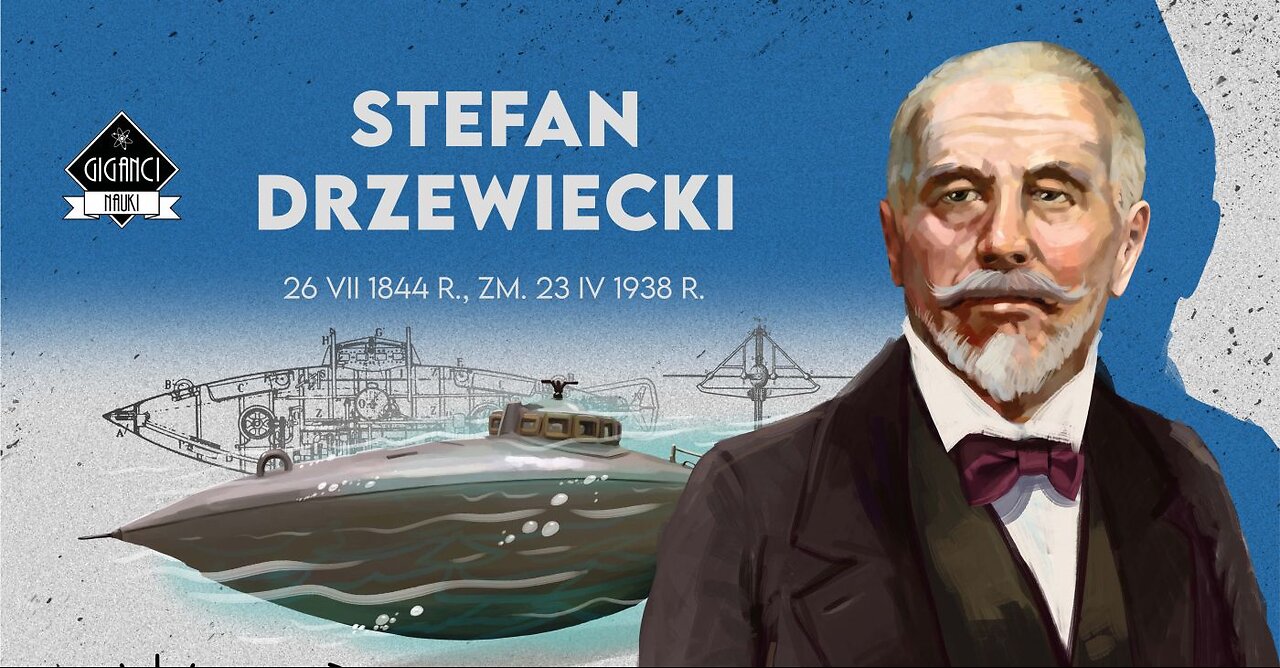Premium Only Content

Polish Genius : Stefan Drzewiecki
Without him, progress in the construction of submarines, airplanes and rail transport would have occurred much later. Despite this, few people remember him. Why? Stefan Drzewiecki came from a respected landowner family that had the Nałęcz coat of arms. A particularly distinguished member was his grandfather, Józef Borsza-Drzewiecki from Drzewica, who lived in the years 1772–1852. In 1792, he was still a member of the Sejm of the Republic of Poland. Seeing that things were going badly in Poland, he joined the Kościuszko Uprising, in which he achieved the rank of colonel. Later he was a soldier of the Legions and the Danube Legion. In turn, Stefan's father, Karol Borsza-Drzewiecki, was a writer and playwright. He took part in the November Rising in 1831. Stefan's mother was Hortensja Jaroszyńska from Jaroszynka, coat of arms Jaroszyński. Stefan was born in 1844 in Kunka, a family estate in the Podolia Governorate, Hajsyn County, Podolia (in present-day Ukraine). His father was particularly interested in his son's education. When he was only 15 years old, he was sent to the Jesuit-run high school in Paris called St. Barbara. However, Stefan was not thinking about learning at that time, but about what kind of trick he could play on his teachers... According to Dorota Szlompek, his stay at school ended in a scandal. Because although he obtained the highest grades in all subjects in his high school leaving exam, the Jesuits decided to... expel him from school due to the fact that he did not put much effort into learning. No high school final exams. Because - in their opinion - it would set a bad example for other students. However, not every school expected passing the Matura exam. This is how Stefan Drzewiecki ended up at an industrial school at the higher level - L'Ecole Centrale des Arts et Manufactures. He found his way there without any problem. He acquired enormous mathematical knowledge. He obtained an engineering degree. There he met Gustave Eiffel, the future designer of the famous tower in Paris, named after him. This friendship benefited both of them: thanks to Drzewiecki's inspiration, Eiffel built the world's first laboratory equipped with a wind tunnel. The Pole, in turn, could later use this laboratory. In the following years, a lot happened in Stefan Drzewiecki's life. Upon learning of the outbreak of the January Uprising, he decided to return to Polish lands and probably continue his proud family traditions. But did he actually take part in it? The authors' opinions are divided here. In any case, Drzewiecki suffered greatly from the suppression of the uprising and subsequent repressions against Poles.
In 1864 he decided to return to Paris to resume his interrupted studies. Already in 1867, he developed his first invention. It was an odometer intended for horse-drawn carriages, or simply a mileage counter. In the following years, his work was again disturbed by great history: the outbreak of the Franco-Prussian War. Drzewiecki joined the Paris Commune, and when the Communards were defeated, he decided to close the French period of his life for a while. He left for Vienna.
-
 1:06:37
1:06:37
Sean Unpaved
1 hour agoCincinnati's Sack King Stays: Decoding the Deal & the NFL's Open-Ended Questions
4.76K -
 LIVE
LIVE
StoneMountain64
1 hour agoWARZONE LEGEND RETURNS. GHILLIE SUIT $20k TOURNEY.
180 watching -
 2:11:17
2:11:17
Side Scrollers Podcast
3 hours agoINSANE Illegal Migrant Propaganda Xbox Game + Paypal REFUSES To Pay Dev + More | Side Scrollers
9.32K -
 1:02:18
1:02:18
Timcast
2 hours agoDemocrat States Ignore English Language Mandate For Truckers, DoT Vows Crackdown Amid Trucker Mayhem
117K36 -
 1:57:04
1:57:04
Steven Crowder
5 hours agoAdios & Ni Hao: Trump Sends Abrego Garcia to Africa But Welcomes 600K Chinese to America
248K210 -
 LIVE
LIVE
The White House
4 hours agoPresident Trump Participates in a Cabinet Meeting, Aug. 26, 2025
2,565 watching -

Rebel News
1 hour agoCarney's flawed LNG deal, Libs keep mass immigration, Poilievre's plan to fix it | Rebel Roundup
4.73K6 -
 27:39
27:39
Crypto.com
4 hours ago2025 Live AMA with Kris Marszalek, Co-Founder & CEO of Crypto.com
54.2K4 -
 DVR
DVR
TheAlecLaceShow
2 hours agoMAGA Pushback Against Flag Burning EO & 600K Chinese Students | Cashless Bail | The Alec Lace Show
6K -
 1:09:18
1:09:18
SGT Report
17 hours agoBIOHACKING 101: MAKING BIG PHARMA IRRELEVANT -- Dr. Diane Kazer
27.1K20